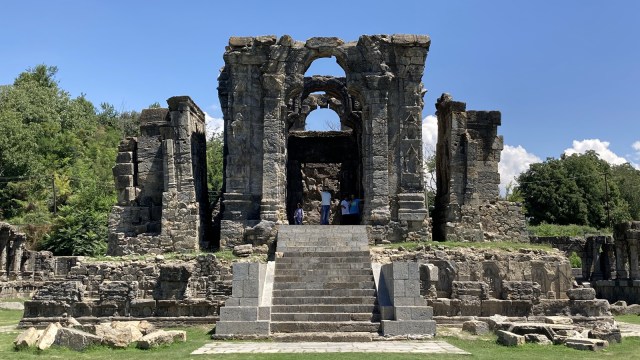A parliamentary panel has recommended the government to explore the possibility of permitting puja and worship at monuments protected by the Archaeological Survey of India (ASI) that have religious significance. The report on ‘Issues relating to Untraceable Monuments and Protection of Monuments in India’ was presented in both Houses on Friday.

In its recommendations, the committee — headed by YSR Congress Rajya Sabha MP V Vijaisai Reddy and including more than a dozen MPs from across political parties — said that “several historical monuments across the country hold immense religious significance to a large number of people and allowing pujas/worship/certain religious activities at such monuments can fulfil legitimate aspirations of the people”.
Story continues below this ad
It recommended that the ASI may explore the possibility of permitting puja/worship/certain religious activities at Centrally Protected Monuments of religious significance, subject to the condition that such activities would not have any detrimental effect on the state of conservation and preservation of the monuments.
In its response, the Ministry of Culture said it had noted the recommendation and will explore its feasibility. It, however, said that as per the policy decision, revival of worship is not allowed where it was not in vogue at the time of protection (by the ASI) or has been abandoned since long.
In May last year, after prayers were held at the ruins of the eighth-century Martand Sun Temple in Jammu and Kashmir’s Anantnag, the ASI had expressed its concern to the district administration. The agency, which functions under the Ministry of Culture, deemed the incident to be a violation of its rules.
According to ASI rules, prayers are allowed at its protected sites only if they were “functioning places of worship” at the time it took charge of them. “No religious rituals can be conducted at non-living monuments where there has been no continuity of worship when it became an ASI-protected site,” an ASI official said. Sources say there has been a feeling among the regime that prayers should be permitted at significant ancient temples and sites even as they may be ‘non-living’ monuments technically.
Story continues below this ad
Of the 3,693 centrally protected monuments and archaeological sites maintained by the ASI, a little less than a fourth (820) have places of worship, while the rest are considered non-living monuments where no new religious rituals can be started or conducted. The sites that have places of worship include temples, mosques, dargahs and churches.
Although the Martand Sun Temple was once a thriving place of worship, commissioned by Karkota dynasty king Lalitaditya Muktapida (725 AD to 753 AD) in the eighth century, it was destroyed by Sikandar Shah Miri in the 14th century. At the time the ASI took over the temple ruins in the 20th century for conservation, no puja or Hindu ritual was being held there. So, when puja was conducted on the temple complex twice last year — first by a group of devotees and then in the presence of J&K Lieutenant-Governor Manoj Sinha — it was a violation of ASI norms since the temple is considered a non-living monument, ASI officials said.
Meanwhile, the panel also lashed at the Ministry as it could provide action-taken notes on “only 21 of the total of 35 recommendations” made in its relating to “untraceable monuments”, which was made public in September 2023.
“….the Ministry could manage to provide Action Taken Notes on only 21 out of the total of 35 recommendations as contained in the 324th Report, by 4th October, 2023, i.e., after a period of 1 year and 19 days,” the statement said. The committee said that “disregarding or trivialising” its views undermines the trust, credibility and seriousness of the ministry.
Story continues below this ad
According to the committee, the report was forwarded to the ministry for necessary action on June 15, 2022.
The department-related Parliamentary Standing Committee on Transport, Tourism and Culture in its report also expressed a “deep concern and disappointment at this apparent lack of seriousness”, on the part of the ministry in responding to the panel’s recommendations addressing critical issues.
It reiterated that the ministry and ASI must “conduct the survey for identifying monuments on priority, in a time-bound manner”. It recommended that the survey results “must be placed in public domain” and include the data relating to expenditure incurred on them and the problems in and around the monuments.
Why prayers are held at some protected sites?
According to ASI rules, prayers are allowed at protected sites only if they were “functioning places of worship” at the time it took charge of them. The best-known example of a living ASI monument is the Taj Mahal where namaz is held every Friday. Other notable living monuments include three mosques in Kannauj, Roman Catholic Church in Meerut, Nila Mosque in Delhi’s Hauz Khas Village and several Buddhist monasteries in Ladakh. Many protected monuments also witness “unauthorised worship”, according to ASI records. These include Lal Gumbad, Sultan Ghari’s tomb and Ferozeshah Kotla, all in Delhi.









